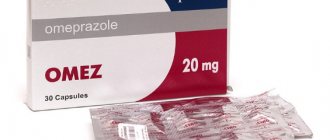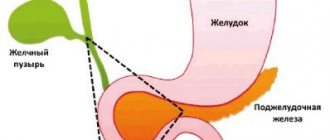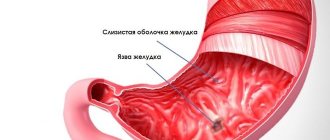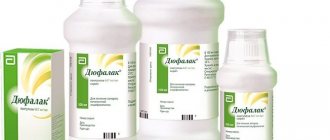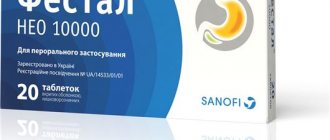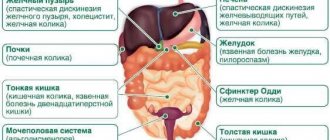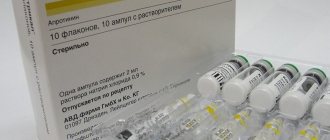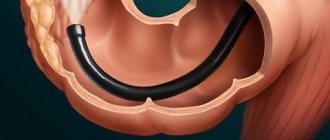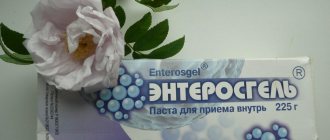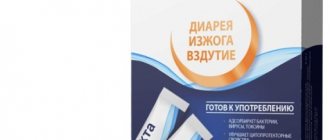Published 04/07/2020 · Comments: · Reading time: 11 min · Views: Post Views: 16,025
A regular cause of digestive disorders is ulcerative lesions of the walls of the stomach, esophagus or intestines. They can lead to the development of intense pain, debilitating heartburn, and sour or bitter belching. To relieve unpleasant symptoms and speed up healing of ulcers, intestinal antiseptics with an astringent effect are used. The drug "De-Nol" is one of the representatives of this group of drugs.
Mechanism of action
De-Nol's work is based on gastrocytoprotective, astringent and antimicrobial effects.
The principle of the enveloping effect of De-Nol is associated with the chemical transformations of bismuth citrate in an environment with low pH (pH≤4.0). Under the influence of acids that catalyze the reactions, the soluble bismuth salts from the tablets react with hydrochloric acid in the stomach, forming an insoluble precipitate. In the form of a film, it covers the affected areas of the mucosa, thereby stopping the ingress of enzyme-rich gastrointestinal contents, food and digestive acids into them.
The specificity of film formation specifically in the affected areas is due to the fact that Bismuth salts also form chelated intermolecular attachments to protein structures that appear when the epithelial layer and connective tissue are damaged in the area of erosions and ulcers.
The antibacterial effect is associated with a specific effect on Helicobacter pylori. De-Nol is able to block pro-theolytic enzymes, penetrating deep into microbial cells, as well as bind to proteins on the membrane and cause a violation of permeability. Thus, the ability of bacteria to move and reproduce is reduced, which inhibits their growth and spread throughout the digestive system. Today, no Helicobacter strains resistant to bismuth have been discovered.
The cytoprotective effect is manifested by the following complex:
- Stimulation of hyperproduction of PG E2, which increases the amount of mucin (a protective astringent protein in the gastric secretion) and a change in the buffering properties of the juice by increasing the concentration of bicarbonates. PG E2 stimulates mucocytes in the stomach, which leads to the production of more mucus;
- Improving the functioning of the capillary bed of the anterior sections of the duodenum, which promotes rapid cell healing due to the active flow of blood enriched with oxygen and nutrients;
- Reduced activity of fundic gastroepithelial cells (cells that produce hydrochloric acid), which reduces the acidity of the chyme;
- Conjugation of bismuth salts with the proteolytic enzyme pepsin, which takes part in the destruction of protein structures that form the walls of the stomach. Bismuth leads to its inactivation in an acidic environment.
De-nol: all indications for use and myths about prevention
The bismuth-based drug has a number of useful medicinal properties, due to which it is actively used in the treatment of diseases of the digestive system.
The article describes the composition, rules of use and indications for use of De-Nol. The main active ingredient of the medicine is bismuth tripotassium dicitrate. The medication itself is an effective gastroprotector and is considered an antiulcer agent. The main form of release is 120 mg tablets, which are coated on the outside with a protective coating.
Therapeutic effects of the drug:
- Protection of the mucous membrane of the stomach or duodenum. Bismuth forms a thin film that covers the damaged areas of the epithelium. This prevents irritation and further damage to the inflamed mucosa by the components of gastric juice.
- Antimicrobial effect against Helicobacter pylori. Due to this, De-Nol is prescribed to eradicate the bacteria. Bismuth disrupts the structure of the walls of microorganisms, prevents their attachment to the integumentary epithelium, and suppresses bacterial aggression.
The medicine has anti-inflammatory and antimicrobial effects, but in a global sense it is not considered an antibiotic. A bismuth derivative should always be prescribed in combination with other antibacterial agents.
Excretion of the substance from the body occurs primarily through the lower gastrointestinal tract. Only a small amount is excreted through the kidneys in the urine.
Indications
Instructions for use of De-Nol provide the following indications:
Despite the fact that the drug has virtually no contraindications, it can only be taken after consultation with a doctor. De-Nol is often used to prevent seasonal exacerbations and prevent infection with the Helicobacter pylori bacterium.
Fact! The drug combines well with penicillin and macrolide antibiotics, which are also effective for stomach ulcers and chronic gastritis associated with Helicobacter pylori infection.
It can also be used in the following cases:
- pulpitis;
- duodenitis;
- dyspeptic disorders;
- chronic diarrhea;
- malabsorption of nutrients.
De-nol for atrophic gastritis is considered one of the safest drugs. It is necessary for exacerbations of chronic diseases. A gastroenterologist can prescribe it for bacterial inflammations and erosions that appear after long-term treatment with other drugs.
De-Nol for gastritis
Treatment of gastritis should always be comprehensive: diet, normalization of lifestyle and regular use of medications. Before prescribing therapy, the doctor refers the patient to gastroscopy, which can be used to determine the form of gastritis and the level of acidity of gastric juice.
De-Nol is used for gastritis only if a pathogenic strain of Helicobacter pylori is detected in the stomach cavity, as well as a high concentration of hydrochloric acid. In this case, the drug will protect the inner wall of the stomach from the aggressive environment of digestive juice and suppress the growth of bacteria.
De-Nol can be taken in two ways:
- 2 tablets in the evening and in the morning half an hour before eating.
- One tablet three times a day, 30 minutes before meals and before bedtime.
Chronic inflammation of the stomach has several varieties, one of which is atrophic gastritis. De-Nol is sometimes included in his treatment. But one drug containing bismuth will not be enough for effective therapy.
The doctor may prescribe additional medications to the patient:
- Abomin;
- Acidin-pepsin;
- Limontar;
- Plantaglucid.
For stomach ulcers
Since in most cases the etiological factor of peptic ulcer is Helicobacter pylori infection, De-Nol is often included in eradication therapy (removing microbes from the body).
Together with other drugs (antibiotics, antisecretory agents), De-Nol treats infection, relieves pain and reduces signs of inflammation in the stomach or duodenum.
For stomach ulcers, the drug is prescribed in a standard dose (one tablet 4 times a day) for a period of 2 or 4 weeks. The duration of therapy can only be adjusted by a doctor.
For gastroduodenitis
Gastroduodenitis is a combined inflammation of the mucous lining of the stomach and duodenum. The disease is accompanied by symptoms similar to chronic gastritis. If H. Pylori was detected during gastroscopy, then tripotassium dicitrate can be added to the treatment.
For gastroduodenitis (during an exacerbation), the medicine should be taken half an hour before meals with a small amount of water. The optimal frequency is 4 times a day, one tablet or twice a day, 2 tablets.
For reflux esophagitis
Since De-Nol has a protective effect on the mucous membranes of the gastrointestinal tract, it is also successfully used for reflux esophagitis, when inflammation in the esophagus develops against the background of constant reflux of stomach contents.
The medication may be part of the treatment of frequently recurrent GERD, when antisecretory, sedative and prokinetic drugs are not effective. But heartburn is not a direct indication for the use of bismuth; such a decision can only be made by the attending physician.
In which cases the medicine is prohibited, it is recommended to read the instructions or article - contraindications to the use of De-Nol.
De-Nol as a preventive measure
The drug is approved for use as a prophylaxis for peptic ulcer disease. It is also important to undergo a short therapeutic course for other chronic gastrointestinal diseases during remission (gastritis, duodenitis, gastroduodenitis, colitis).
However, the main prevention of diseases of the digestive system is a balanced diet, regular rest and giving up bad habits. Taking De-nol is allowed only after consultation with a doctor. For frequent exacerbations of gastritis or peptic ulcer, inpatient treatment with preliminary gastroscopy is recommended.
What is good about the drug?
With regular use of De-Nol, you can put the underlying disease into stable remission and significantly reduce the number of pathogenic microbes on the stomach wall.
It is important to know! It is not recommended to take the drug for more than 8 weeks, and it is completely contraindicated during pregnancy and breastfeeding. This is explained by the fact that no clinical trials have been conducted to prove the safety of the drug for the expectant mother and fetus.
The medication is effective for atrophic gastritis, when thinned areas appear on the stomach wall and the glands lose their functional significance.
The drug has a number of other positive properties:
- an increase in the volume of mucus secreted, which protects the internal walls of organs and promotes the healing of erosions and ulcers;
- elimination of the synthesis of prostaglandins – mediators of inflammation;
- suppression of the reproduction of the Helicobacter bacteria;
- reducing the aggressiveness of gastric juice;
- reducing the intensity of the inflammatory process.
If the drug is contraindicated, De-Nol analogues should be considered to treat the disease.
Despite the abundance of therapeutic effects, any therapy for chronic gastritis, gastroduodenitis or peptic ulcer due to Helicobacter pylori infection should include a combination of antibiotics.
Only they are fully capable of suppressing the reproduction and growth of a common cause of inflammatory pathology of the gastrointestinal tract - the bacteria Helicobacter pylori.
Source: https://lechigastrit.ru/lekarstvennye-sredstva/de-nol-pokazaniya-k-primeneniyu.html
Rules for taking De-Nol
According to the above, the answer to the question of whether to take De-Nol before or after meals is obvious.
The medicine should form a protective barrier on the surface of the mucosal defect, so the stomach should be empty before taking it. For a film of bismuth salts to appear, you need to drink De-Nol before meals, no earlier than 30 minutes before the start of the meal . In this case, the medication is washed down with clean water.
Half an hour before and half an hour after taking De-Nol, you should not eat drinks that can inactivate the medicine: tea, juice, coffee, milk and food products containing it, cocoa, carbonated water, alcohol.
Since alcohol provokes an increase in stomach acidity and has an irritant effect, it is recommended to exclude drinks containing it until the end of the therapeutic course.
In order for the active components of the medicine to become soluble and act in the stomach, De-Nol must be drunk with plenty of water.
Reviews
Dear readers, your opinion is very important to us - therefore, we will be happy to review the drug about De-Nol in the comments, this will also be useful to other users of the site.
Alena: For as long as I can remember, I have always tried to get rid of excess weight, but in the end I never succeeded, and in addition to the extra pounds, I also acquired gastritis. For a long time I did not attach any importance to the appearance of discomfort after eating, and when the pain became more intense, I decided to turn to specialists. The doctor scolded me and sent me for tests and an ultrasound, as a result of which a diagnosis was made - chronic gastritis. As a treatment, De Nol and a diet were prescribed, and quite strict for the period of exacerbation. One of the medicines was De Nol, and I did not immediately feel the results from use. At first I thought that it was not helping me, and only after a month and a half did I feel relief. The pain in the stomach disappeared, digestion improved. After another examination, the doctor allowed the use of many previously prohibited foods.
Olga: the drug turned out to be effective, but I think it’s a little expensive. The course required two packages, which is expensive for a young family. You can find more affordable medications in the same direction, especially if gastritis is not advanced.
Katerina : when I began to worry about discomfort in my stomach, the doctor sent me for examination. As a result, the bacterium Helicobacter pylori was discovered, which most often causes gastric pathologies. De Nol was prescribed as a therapeutic drug, which successfully fights this microorganism. After the course of treatment, the tests were good, no traces of bacterial activity were found. But to prevent a relapse, the doctor decided to conduct an additional course of treatment.
Take after meals
Although it is correct to take De-Nol before meals, it is not always easy for patients to time their meals and medications. This is why patients often ask whether De-Nol can be taken after meals and what time intervals should be between eating and drinking the medicine.
The length of time chyme remains in the stomach is influenced by many factors : the presence of a disorder of motor-evacuation function, the level of acidity and the amount of enzymes in the digestive juice. But on average, depending on the type of food, it is digested approximately:
type of product | Exposure in the stomach |
| Liquids: drinks, vegetable broths | 15-20 min |
| Vegetables and fruits without dressing | 30-40 min |
| Root vegetables and seasoned vegetables | 50 min - 1 hour |
| Eggs, fish | 1 hour |
| Starchy foods (cereals, potatoes, etc.) | 1.5-2 hours |
| Dairy | 2 hours |
| Bird | 2.5-3 hours |
| Nuts, beans | 3 hours |
| Lean red meat | 4 hours |
| Fat meat | 5.5-6 hours |
The time interval between eating and taking the drug will depend on what was eaten before taking De-Nol.
The instructions indicate that after eating you can drink De-Nol after at least two hours have passed from the end of the meal. But if the patient is on a fasting diet and eats light food, such as vegetable soups, fish, boiled vegetables and eggs, it is allowed to take De-Nol an hour after meals.
After the contents are evacuated into the duodenum, at least half an hour must pass, so the instructions indicate that you should drink De-Nol two hours after eating.
Contraindications, overdose, side effects
It is necessary to take De-nol correctly to avoid side effects. Using De-nol according to the instructions, following the dosage and rules of administration help to avoid adverse reactions.
The following reactions can be observed as side effects:
- itchy skin, urticaria;
- inflammation and swelling of the gums, blackening of the tongue;
- failure of the kidneys;
- nausea, sometimes with vomiting, constipation, alternating with diarrhea;
- unpleasant taste and odor from the mouth after using the medicine;
- acquisition of black stool;
- attention and memory disorder (in rare cases);
- encephalopathy is possible, which is caused by the accumulation of bismuth in the body (with long-term use of the drug).
Gastrointestinal manifestations can occur frequently, but are usually temporary and do not require additional treatment, as they resolve on their own.
If symptoms of allergic reactions or encephalopathy appear, stop taking the drug and consult a doctor.
Pregnancy and breastfeeding are considered contraindications. If the situation requires the nursing mother to take the drug, breastfeeding must be stopped.
Other contraindications include: the presence of severe renal dysfunction, intolerance or hypersensitivity to the components of the drug, recent use of drugs with the same active substance or a similar effect.
When the treatment regimen contains, in addition to De-nol, antacid drugs to get rid of heartburn, De-nol is taken separately from them, since such drugs reduce the effect of its effect. For the same reason, it is forbidden to drink milk at the same time as taking the drug.
Kidney damage is possible if a very large dose is taken (10 or more times the permitted dose). In case of bismuth poisoning, gastric lavage is performed, treatment with enterosorbents (Polysorb, Polyphepan, Enterosgel, white carbon, activated carbon, Filtrum-STI) and laxatives (Magnesium sulfate salt) is prescribed; in especially severe cases, hemodialysis is performed.
Antispasmodics may be prescribed for pain relief. If there is a large amount of bismuth in the blood against the background of kidney pathology, complexing acids can be used. They enter into a chemical reaction with bismuth and precipitate it in the form of salts.
Doses and frequency of administration
Taking De-Nol depends not only on food, but also on the age of the patient.
The medicine is prescribed from the age of 4, according to two- or four-time dosage regimens:
- For patients under 8 years of age, the medication is calculated individually, based on the child’s body weight. You need to take from 4 to 8 mg/kg body weight per day. The dosage per day should not exceed 2 tablets, and the medicine is divided into two doses, one of which should be before bedtime;
- From 8 to 14 years of age, take 1 tablet of De-Nol before meals. It is recommended to take the medication in the evening at night;
- Adults should drink De-Nol four times: three doses should be before meals, and the last one at night. You should take 1 tablet of medication at a time.
Treatment lasts for 1 to 2 months (30-60 days; 4-8 weeks). Time restrictions are associated with the ability of bismuth compounds to accumulate in brain tissue and affect kidney function.
The break in treatment to remove residual doses lasts at least 10-14 days, which is primarily due to the need to prevent kidney dysfunction.
If the doctor sees the need to continue taking De-Nol, it makes sense, after the treatment course has passed, to take a test to determine the amount of bismuth in the blood. The normal value for individuals who have just completed therapy is ≤0.56 nmol/ml.
Regimens and doses of De-Nol for the treatment of GERD
Therapy of gastroesophageal reflux disease requires an integrated approach involving medications and diet therapy. During rest, the patient is recommended to be in an elevated position: the head end of the bed is at a distance of up to 20 cm, high pillows. Spicy, fatty, heavy, fried foods are excluded from the diet. It is also recommended to avoid coffee, chocolate, soda, citrus fruits, garlic, and onions. Food is taken often, in small portions, and overeating is avoided. The last meal is 3.5-4.5 before bedtime.
Drug therapy involves the use of proton pump inhibitors based on omeprazole or lansoprazole, antacid drugs as a means of symptomatic therapy (Reni, Maalox). The tablets should be taken together. De-Nol can be used in several ways:
- 1 tablet up to 4 times a day: on an empty stomach, before each meal (half an hour before), and also before bedtime,
- two-time use: on an empty stomach before breakfast, in the evening before going to bed. The medicine is washed down with purified, plain water. Milk, juices, decoctions, compotes are not suitable for this purpose and are incompatible with De-Nol.
It is necessary to maintain an interval of at least 60-120 minutes between the use of bismuth and other groups of medications recommended by the doctor.
Bismuth is used as part of complex therapy, along with other groups of drugs prescribed by a gastroenterologist. The drug is not intended for self-medication; it is used after a comprehensive diagnosis.
Contraindications
De-Nol has a small list of contraindications:
- Age less than 4 years. There are two reasons: greater susceptibility to the toxic effects of bismuth compounds and immaturity of the kidneys (their formation continues during the first 2 years of life);
- in order to avoid the toxic effect of bismuth salts on the fetus, De-Nol is prohibited from drinking during pregnancy;
- the drug can pass into breast milk, so it is not used in women who are breastfeeding children;
- De-Nol is not used if the patient has severe kidney failure;
- intolerance to the components of the drug.
Side effects
De-Nol can provoke the following conditions:
- Allergies of anaphylactic (immediate) and delayed type (dermatitis);
- symptoms of dyspepsia: vomiting, changes in stool, nausea;
- encephalopathy: deterioration of memory and ability to concentrate, impaired motor coordination; provoked by prolonged excess of recommended doses and course of therapy;
- nephropathy: deterioration of kidney function, proteinuria. Signs of insufficiency in the absence of a history of kidney disease disappear 10-14 days after discontinuation of the drug without additional measures;
- darkening of the tongue, swelling of the gums and the appearance of a bluish border on them.
The last three conditions usually indicate an overdose of De-Nol and excessive accumulation of bismuth. If these manifestations occur, the patient’s stomach should be rinsed, sorbents (activated carbon) and an osmotic laxative should be given.
With a complicated history of the urinary system, hemodialysis may be required.
Side effect
Reviews about the drug De-nol are mostly positive. Side effects occur extremely rarely and only with an overdose of the drug.
If the rules of administration are not followed, the following conditions may occur:
- feeling of nausea turning into vomiting,
- bloating,
- indigestion, manifested in the form of persistent constipation or diarrhea,
- allergic reactions (rash on the skin, respiratory dysfunction, etc.).
De-nol is excreted from the body slowly, together with urine. Consequently, in case of an overdose, there is an excessive load on the kidneys, which can provoke the development of renal failure and dysfunction of the central nervous system.
Conclusion
Taking De-Nol is time-consuming with eating, and also requires avoiding certain foods for half an hour before taking the medication and half an hour after that.
The need to drink De-Nol before meals is associated with the peculiarity of its action, which manifests itself in the formation of a protective layer over erosions or ulcers of the gastrointestinal tract. The enveloping effect of De-Nol helps to get rid of the severity of symptoms of peptic ulcers or inflammation of the gastric and duodenal mucosa.
The uniqueness of De-Nol in the treatment of peptic ulcers and gastroduodenitis lies in the simultaneous symptomatic, etiotropic and pathogenetic action of the drug, that is, the treatment of all parts of the pathological process.
Composition and release form
De-Nol helps well against heartburn thanks to the bismuth tripotassium dicitrate included in its composition, which is the active component of the medicine. This substance has several therapeutic effects - enveloping, astringent, anti-inflammatory and antimicrobial. Additional components enhance the effect of the drug - microcellulose, corn starch, etc.
The medication is available in the form of tablets for oral administration, packaged in cellular packaging of 8 pieces. Blisters are placed in cardboard boxes of 7 or 14 pcs.
